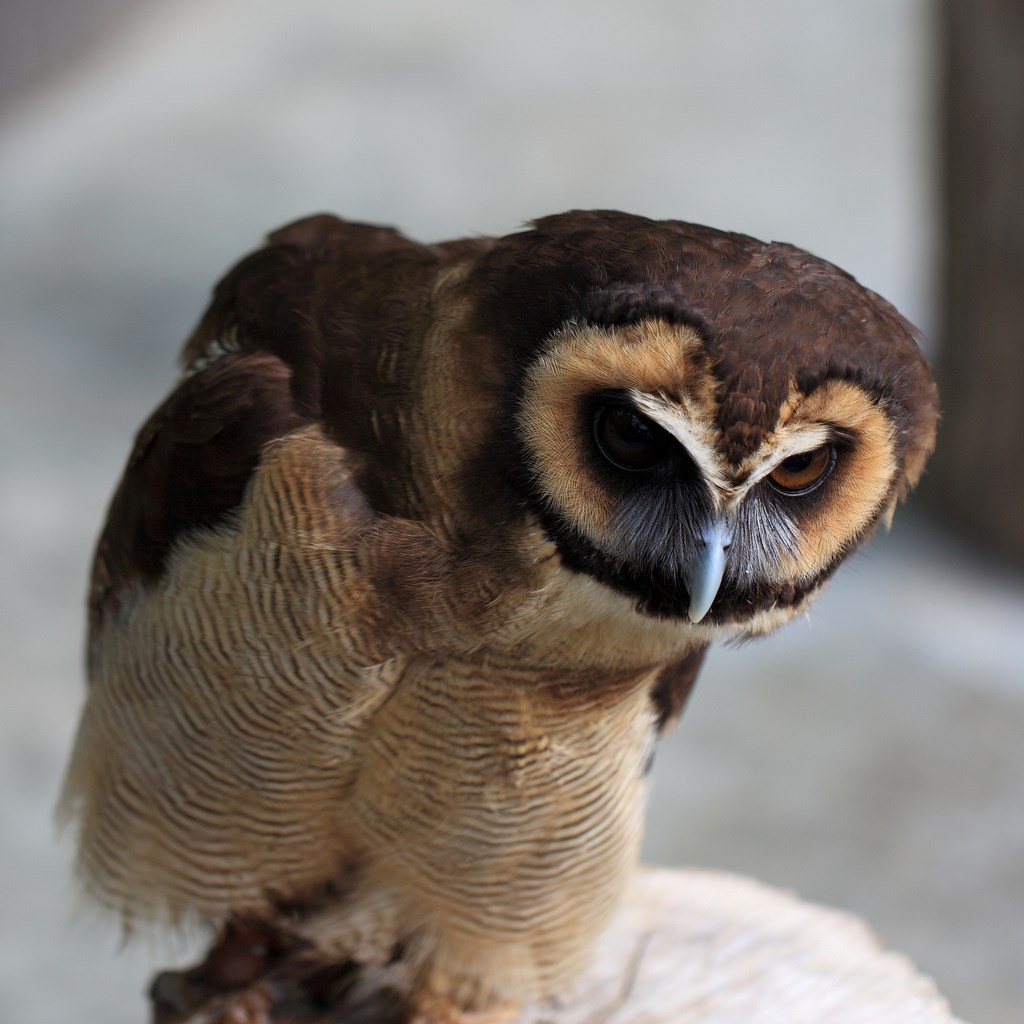Overview
The Asian brown wood owl is one of the larger owls, with an average length of between 45cm to 57cm. They are perfectly camouflaged to their forest surroundings, with the main body a light chestnut brown, and barred with dark brown and white with faint white patches on the shoulders, and buff and brown streaked under parts. There is a facial disk, buff in colour and edged with a dark brown border, which extends to the dark brown crown. There is a white neckband. Both the male and female are similar in appearance.

All about us
| Distribution: | South Asia from India and Sri Lanka east to western Indonesia and south China. |
|---|---|
| Habitat: | Tropical and temperate forest |
| Height: | 45cm to 57cm in length |
| Weight: | 500g to 700g |
| Lifespan: | Wild unknown, approximately 15 years in captivity |
| Threats: | Habitat loss and deforestation |
About us
Scientific name: Strix leptogrammica
Although not classed as endangered, this species in not commonly found in the wild, and so little is known about this species. There are fourteen subspecies throughout its vast range, which includes Asia, India, Sri Lanka, China, and Indonesia. They are part of the Strix genus, known as the ‘wood owl’ family, and are closely related to the Tawny owl found in the UK. They are often referred to as the ‘Asian brown wood owl’ or ‘Malaysian brown wood owl’.

Asian Brown Owl facts
The brown wood owl is one of the larger owls, with an average length of between 45cm to 57cm. They are perfectly camouflaged to their forest surroundings, with the main body a light chestnut brown, and barred with dark brown and white with faint white patches on the shoulders, and buff and brown streaked under parts. There is a facial disk, buff in colour and edged with a dark brown border, which extends to the dark brown crown. There is a white neckband. Both the male and female are similar in appearance.
The wings of an owl are finely serrated so that they can fly silently. This is to allow the owl to approach its prey silently without it hearing it first, and so that they owl itself can hear its prey over its own sounds.
The eyes of owls are adapted to be like a pair of binoculars. They are fixed in place, allowing for detailed long distance vision for hunting, but this does mean their close range vision is very poor. The eyes of a brown wood owl are dark brown in colour, and are large to allow heat loss. To look around the owl has to move its entire head, it is a common myth that they can turn their head all the way around, it actually only rotates around 270 degrees horizontally, and around 90 degrees vertically. To be able to do this the owl has extra bones in their neck. Most vertebrates, including us, only have 7 vertebrae in their neck, whereas an owl has 14.
To cope with the lack of short range vision they have a group of sensitive feathers, called crines, around their beak. These sensitive feathers are used to locate dead prey.
Owls have very sensitive hearing, used to locate prey either hidden under snow or other coverings, or to hunt in the dark. Owl’s ears are holes hidden beneath the feathers, one further up than the other, allowing the owl to pinpoint the location of a sound. This ability lets them build a sort of sound map and locate prey, often in complete darkness, by sound alone. The feathers of an owl’s face help with this hearing, by forming a facial disk, a disk of feathers used like a satellite dish to help point any sound towards these ears.
The Brown wood owl feeds mainly on small mammals. It will also feed on fruit bats, reptiles, insects and a range of birds, up to the size of a pheasant.
The brown wood owl is a nocturnal species. The large dark brown eyes are adapted for night vision, and allow them to hunt their prey in the forest in low light.
The strong feet and talons are used to catch the prey, which is then dispatched with a nip through the back of the skull with its beak. Depending on the size of the prey item they will swallow it whole, or if larger tear it apart with the beak. Owls produce a pellet, a small package of all the parts of their food they cannot digest, such as the bones and fur or feathers.
The wings of an owl are finely serrated so that they can fly silently. This is to allow the owl to approach its prey silently without it hearing it first, and so that they owl itself can hear its prey over its own sounds.
The brown wood owl has several distinct calls, the most heard are a (hoo) hoo hoo HOO or a deep goke-goke-ga-LOOO or a loud scream. The alarm call is a bark, wow-wow. Some subspecies are known to produce distinct vocalizations, depending on their geographical range. The young owlets will make a series of calls in the nest, including calls to get attention and when squabbling with nest mates.
When threatened or acting aggressively they will make a loud clicking noise with their beak, with wings spread as a threat display.
Little is known about the breeding habits of the brown wood owl. Breeding usually occurs from January to April, with the female laying one to two eggs, which she will incubate for around 30 days. They will nest in tree cavities, or occasionally caves.
All of our birds of prey are flown daily. This has many benefits to the animal. Firstly it allows the animal to exercise, keeping them fit, and developing flying muscles. It also allows them to perform their natural behaviours, for some of our birds of prey this may include various hunting techniques such as catching prey mid-flight, and chasing down ground prey, or killing a (rubber) snake.
Each bird has a varied diet, just as it would in the wild, mimicking the varying nutritional properties of each food type and the quantities.
Adult brown wood owls are rarely preyed upon. They are however commonly mobbed by smaller birds when roosting. This is often used as a good indicator to locate them in the wild.
Deforestation and human disturbance are thought to be the main cause of the decline of this species. It is not classified as endangered; it is seen as ‘least concern’ by the IUCN red list, mostly due to its large range, even though in some parts of this range is it very uncommon.
They are listed as appendix II of CITES, which means the trade and export of this species is heavily regulated and controlled to protect them.

